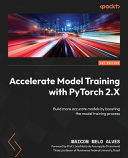

Most ebook files are in PDF format, so you can easily read them using various software such as Foxit Reader or directly on the Google Chrome browser.
Some ebook files are released by publishers in other formats such as .awz, .mobi, .epub, .fb2, etc. You may need to install specific software to read these formats on mobile/PC, such as Calibre.
Please read the tutorial at this link: https://ebookbell.com/faq
We offer FREE conversion to the popular formats you request; however, this may take some time. Therefore, right after payment, please email us, and we will try to provide the service as quickly as possible.
For some exceptional file formats or broken links (if any), please refrain from opening any disputes. Instead, email us first, and we will try to assist within a maximum of 6 hours.
EbookBell Team

4.7
16 reviewsYou’ll start by understanding how model complexity impacts training time before discovering distinct levels of performance tuning to expedite the training process. You’ll also learn how to use a new PyTorch feature to compile the model and train it faster, alongside learning how to benefit from specialized libraries to optimize the training process on the CPU. As you progress, you’ll gain insights into building an efficient data pipeline to keep accelerators occupied during the entire training execution and explore strategies for reducing model complexity and adopting mixed precision to minimize computing time and memory consumption. The book will get you acquainted with distributed training and show you how to use PyTorch to harness the computing power of multicore systems and multi-GPU environments available on single or multiple machines.
By the end of this book, you’ll be equipped with a suite of techniques, approaches, and strategies to speed up training , so you can focus on what really matters—building stunning models!